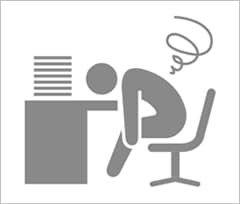|

What is functional dyspepsia (FD)?
What is functional dyspepsia?
|
Functional dyspepsia (FD) is a disease that causes a sense of heaviness in the stomach, pain in the solar plexus, and other irritating symptoms in the stomach, but does not manifest any abnormality that can be observed with an endoscope. The disease is unique in that, although it disrupts the normal functioning of the stomach, it does not reveal itself in any visible form in the gastric mucosa, etc. (i.e., no organic change is caused).
The name “dyspepsia” originates from the Greek words “dys (bad)” and “peptein (digestion)” meaning indigestion. In the past, the term was used widely and ambiguously to refer to such symptoms affecting a variety of digestive organs. However, the first international diagnosis standard covering the symptoms was created in 1991 (Rome Ⅰ Criteria) and subsequently revised, and the most current edition is the Rome Ⅳ Criteria which was published in 2016. According to the Criteria, a person has FD if they report at least one of the following symptoms, absent any known organic disease that could be causing the symptom: everyday life is negatively affected due to the severity of the symptom; the symptom has existed for at least the past six months, and has lasted for at least three months:
①Sense of heaviness in the stomach after meals
②Feeling full early
③Pain in the solar plexus
④Burning sensation in the solar plexus
It was as recently as 2013 when FD became an official disease name that physicians in Japan could use with patients so diagnosed. Thus, the concept of this disorder is relatively new, as it used to be diagnosed as neurotic gastritis, stress-induced gastritis, gastroptosis, etc. According to The Evidence-Based Clinical Practice Guidelines for Functional Dyspepsia (FD) 2014 (edition by the Japanese Society of Gastroenterology), it is estimated that between 11 and 17% of all health examinees and between 45 and 53% of all outpatients reporting some type of gastric symptom in Japan have FD.
|
 |
 |
Types of functional dyspepsia
Depending on the symptoms, FD cases can be classified into the following two types.
・1: Postprandial distress syndrome (PDS)
Symptoms: Feeling of heaviness in the stomach after meals, feeling full early
・2: Epigastric pain syndrome (EPS)
Symptoms: Pain in the solar plexus, burning sensation in the solar plexus
Each of these symptoms is thought to be caused by a motor disorder or hypersensitivity in the stomach. A motor disorder of the stomach could also restrict the stomach from expanding fully, which then renders the person unable to eat normally and to send whatever food is ingested down to the duodenum, resulting in a sense of heaviness in the stomach following each meal. Furthermore, if a person’s stomach becomes hypersensitive, meaning that it becomes overly sensitized to various stimuli, the inner pressure of the stomach increases even with the ingestion of only a small amount of food, causing the person to feel full earlier than normal. Moreover, the stimuli of stomach acid and food trigger pain and burning sensation.
Both of these two types of FD have stress as the root cause. When an at-risk person is exposed to too much stress, the autonomic nervous system loses its balance and the symptom can manifest. Some FD patients even experience symptoms of both PDS and EPS.
Although these symptomatic states used to be commonly diagnosed as a minor stomach malfunction caused by stress, now that it has been officially classified as a disease, its treatment is expected to improve from now on.
What are the consequences of having FD? Could it lead to mental illness if left untreated!?
|
One of the major issues that result from this disease is disruption of patients’ normal activities and interactions with society.
Due to the irritating symptoms that continue, many patients are unable to concentrate on their academic work or professional duties, etc. and report lower quality of life (QOL) as well as significantly reduced productivity as a result. In addition, the patients’ inability to eat meals in sufficient amounts due to faster onset of satiety, etc. can be a serious issue, especially for children and the elderly, as insufficient nutrition hinders the normal physical growth of young children, and also causes senior citizens, whose physical capacity can decline easily, to become less active and to withdraw from society. Depending on the individual, the treatment of FD may be prolonged, and relapse may also occur. While about 50% of all FD patients get well within five years of starting treatment, around 40% suffer the cycle of the symptoms improving and then getting worse again, without fully healing.
Some patients fall into a negative spiral of feeling additional stress by not being cured of the disease after prolonged treatment, which causes the condition of the stomach to worsen further, and so on.
Furthermore, some FD patients lose the motivation to do anything and become mentally distressed due to decreased QOL, and exhibit symptoms of depression. So when one’s stomach is not doing well, the condition affects not only one’s physical health but also mental well-being.
|
 |
 |
Check! Might you have functional dyspepsia?!
If you answer “yes” to any of these questions, be careful!!
|
【Symptoms】
|
 |
【Lifestyle】
|
Supervision: Dr. Ken Haruma (Specially Appointed Professor, Kawasaki Medical School General Medical Center)
|






